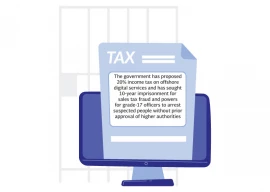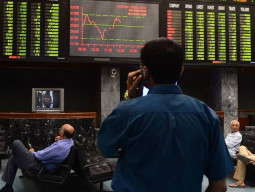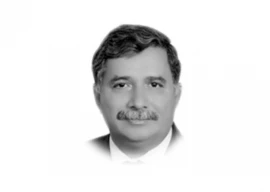
A new legally mandated fiscal policy statement has revealed the worst economic management by the coalition government of the Pakistan Democratic Movement, resulting in expenditures over Rs2.2 trillion higher than budgeted and a 25% increase in the debt burden for every citizen.
The Ministry of Finance’s Fiscal Policy Statement 2024 showed a sharp rise in the debt burden during the fiscal year 2022-23, the period when PDM ruled Pakistan. The debt burden of every citizen increased by 25.2% to Rs271,624 by the end of the previous fiscal year. In absolute terms, every person’s debt burden rose by Rs54,500 within one year, according to the statement. A year ago, the per person debt burden was Rs216,925, according to the Ministry of Finance report. The statement is prepared under the Fiscal Responsibility and Debt Limitation Act (FRDL) and will be placed before the new National Assembly. Although the Ministry of Finance has not officially released the statement, the deadline to present it was January 31st.
The gross public debt jumped to Rs62.9 trillion by June 2023, indicating an increase since then. A more than one-fourth increase in per capita debt in one year signifies the speed at which the country is sinking under the debt burden.
The report stated that the key factors responsible for this rise are interest payments on debt and the exchange rate devaluation effect.
The Ministry of Finance has calculated the per capita debt based on the assumption of a population of 231.5 million people. If the new population census numbers are considered, then the per person debt burden would be Rs260,387, up by Rs44,462 or 21%.
Pakistan was ruled by the PDM from April 2022 to August 2023—an alliance of about a dozen political parties. The large alliance made economic decision-making difficult, and these parties fought hard for thinning fiscal resources. A large and unsustainable Public Sector Development Programme (PSDP) was also the result of the political demands of the alliance partners. The February 8th elections have resulted in a hung National Assembly, and the two largest PDM partners—the Pakistan Muslim League-Nawaz (PML-N) and the Pakistan Peoples Party (PPP)—began negotiations on Friday to form a coalition government.
The Fiscal Policy Statement reflects the challenging economic landscape faced during the fiscal year 2023, marked by significant natural disasters, particularly unprecedented floods that wreaked havoc on the country, according to the finance ministry. The economic repercussions of these floods were extensive, causing a negative impact on growth, displacing millions, and leading to substantial economic losses, it added. However, the policy statement showed that the fiscal slippages mostly occurred in areas unrelated to the floods and were more about imprudent economic management and wrong budgeting.
Read Debt exceeds legal limit by Rs14.5tr
The previous coalition government missed last fiscal year’s annual budget deficit target of Rs4.54 trillion, and the actual deficit came in at Rs6.7 trillion, a record deficit in a fiscal year. In terms of the size of the economy, the total fiscal deficit was equal to 7.9% of GDP, whereas the primary deficit remained at 1%.
The details showed that the fiscal slippages were mainly on account of higher interest payments and higher subsidies—two areas that reveal poor budgeting and slack fiscal controls.
The federal expenditure increased to Rs11.3 trillion as against the budget estimates of Rs9.3 trillion—a slippage of Rs2 trillion or 21.5%, according to the report.
The rise in current expenditures was largely driven by mark-up payments which remained at Rs5.7 trillion—a slippage of Rs1.75 trillion. The finance ministry stated that the sharp increase in interest rates contributed to this rise in current expenditures that may also remain high during the current fiscal year.
It has become the habit of the finance ministry to deliberately understate the interest expenditures every year despite internal projections suggesting higher spending during the budget-making exercise. For the current fiscal year too, the Ministry of Finance’s allocation of Rs7.3 trillion is understated by around Rs1.2 trillion. The finance ministry report stated that the total current expenditures remained at 123.5% of the budget estimates in fiscal year 2023.
The report further stated that the budget estimates of subsidies for the last fiscal year were Rs664 billion. “However, the actual expenditures for the provision of subsidies remained at Rs1.08 trillion,” the report added.
The net revenue receipts of the federal government remained at Rs4.7 trillion—a trillion rupee less than the interest cost that the federal government paid in the previous fiscal year. After the transfer of resources to provinces, Net Federal Revenue receipts were Rs4.7 trillion against the budget estimate of Rs5 trillion.
The pension-related federal expenses were equal to 109% of the budget estimates, and defence expenditures were almost within the budgeted allocations. During the last fiscal year, actual development expenditures of Rs890.3 billion remained slightly above the budget estimates of Rs871 billion.
The PDM government also violated the FRDL Act on two counts—bringing the public debt to 57.5% of the GDP and containing the budget deficit below 3.5% of the GDP.
Published in The Express Tribune, February 11th, 2024.
Like Business on Facebook, follow @TribuneBiz on Twitter to stay informed and join in the conversation.

1737453189-0/fizza-(65)1737453189-0-405x300.webp)


1737448163-0/BeFunky-collage-(15)1737448163-0-165x106.webp)
1737104486-0/fizza-(46)1737104486-0-165x106.webp)





















COMMENTS (1)
Comments are moderated and generally will be posted if they are on-topic and not abusive.
For more information, please see our Comments FAQ